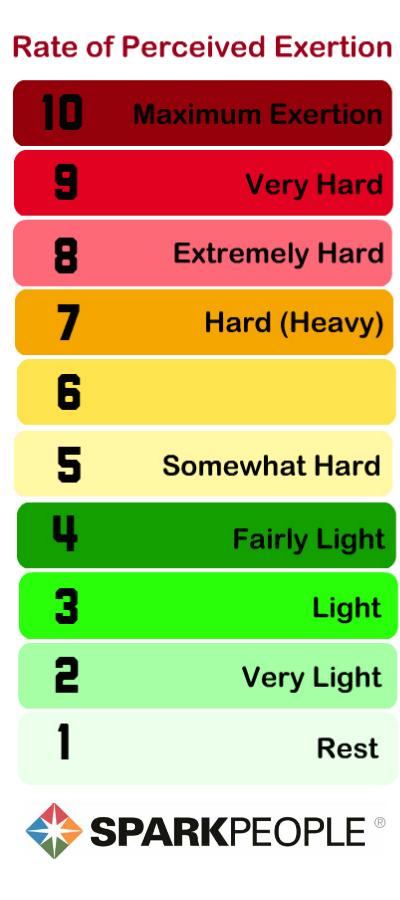One of the most common mistakes new exercisers make is not measuring the intensity of their cardio workouts.
When following an aerobic exercise program, there are three main ways to measure your exercise intensity: Target Heart Rate (THR), Rate of Perceived Exertion (RPE) and the Talk Test. This guide will examine each of these three measures in detail so you can choose which works best for you.
Target Heart Rate
Target Heart Rate (THR) is the most commonly used
A target heart rate range is listed in percentages, typically between about 60 and 85 percent of your maximum heart rate. But how hard you should work depends on your fitness level. In general, beginners should work at a lower range and advanced exercisers should work at a higher range. Keep in mind that some people have exercise restrictions due to injury, health conditions or medications that will affect your recommended intensity level, so always check with your doctor first.
Use the following as a guide for determining your intensity level:
- Beginner or low fitness level: 50 to 60 percent
- Intermediate or average fitness level: 60 to 70 percent
- Advanced or high fitness level: 75 to 85 percent
There are two different formulas you can use to calculate your Target Heart Rate:
1. The Maximal Heart Rate Formula is most commonly used to estimate Target Heart Rate because it’s easy to do and easy to remember. This formula does not take into account fitness level, medical conditions, or other things that might affect your heart rate. It is a good estimate, but may be less accurate than other methods.
How to Use the Maximal Heart Rate Formula
Calculate your Max Heart Rate: (MHR = 220-age)
- Calculate your Max Heart Rate: (MHR = 220-age)
- Plug your numbers into the formula, using percentages that reflect your fitness level (i.e. 50% to 60% for beginners and 75% to 85% for advanced).

How to Use the Karvonen Formula:
- Calculate your Max Heart Rate: (MHR = 220-age)
- Find your Resting Heart Rate (RHR). Prior to getting out of bed in the morning, take your pulse on your wrist (radial pulse) or on the side of your neck (carotid pulse) for one full minute. This is your true resting heart rate. Measuring at other times of day, even at rest, does not yield the same results. To help assure accuracy, take your resting heart rate three mornings in a row and average the 3 heart rates together.
- Plug your numbers into the formula, using percentages that reflect your fitness level (i.e. 50% to 60% for beginners and 75% to 85% for advanced).
 How to Use Your Target Heart Rate Information
How to Use Your Target Heart Rate InformationOnce you have used either formula above to calculate your THR range (in beats per minute), you must try to keep your heart rate within your range during your cardio activity.
Periodically check your heart rate throughout your workout to gauge your intensity level. There are two ways to do this:
- Take your pulse after you
’ve been exercising for at least five minutes. An easy way to check your pulse without interrupting your workout too much is to take a quick six-second count and then multiply that number by 10 to get your heart rate in beats per minute. If your pulse is within your training heart rate zone, you’re right on track! If you notice you are lower than the minimum, increase your speed, incline and/or intensity and count again. If you notice you are very high, decrease your intensity in some way.
- Wear a heart rate monitor. This is the easiest way to monitor your intensity because it does all the work for you—all you have to do is look at a digital watch to see your current heart rate in beats per minute and/or percentages (i.e. 65 percent).
- Your target heart rate (THR) range is an estimate, and it may not be the right exercise intensity for you. It’s based on a formula and not everyone fits into the average. Your THR may change over time as you become more fit too, so consider reevaluating your range every few months.
- Some medications (such as beta-blockers) can affect your heart rate during exercise. An exerciser taking beta-blockers may be working at a high intensity, but might never reach her target heart rate. Therefore, people on this or similar
medications should not use the THR method (see RPE and Talk Test methods below). - Talk to your doctor to determine the best exercise intensity for you
.
Rate of Perceived Exertion (RPE)
Rate of Perceived Exertion (RPE) may be the most versatile method to measure exercise intensity for all age groups. Using this method is simple, because all you have to do is estimate how hard you feel like you’re exerting yourself during exercise. RPE is a good measure of intensity because it is individualized—it’s based on your current fitness level and overall perception of exercise. The scale ranges from 1 to 10, allowing you to rate how you feel physically and mentally at a given intensity level.

An RPE between 5 and 7 is recommended for most adults. This means that at the height of your workout, you should feel you are working "somewhat hard" to "hard."
Tips for using RPE:
- A great way to measure intensity (where appropriate) is by using both the RPE and THR methods. Try to identify where you fall on the RPE scale when your heart rate is between 50 – 70% maximum. This will allow you to accurately use only the RPE scale for measuring intensity when it is not feasible to determine your THR.
- RPE can be the primary means of measuring exercise intensity for people who do not have typical heart rate responses to graded exercise. These people include those on beta blocker medications, some cardiac and diabetic patients, pregnant women, and others who may have an altered heart rate response.
The Talk Test
The final method for measuring exercise intensity is the Talk Test. Like the RPE, the talk test is subjective and quite useful in determining your aerobic intensity, especially if you are just beginning an exercise program.
Using this method, the goal is to work at a level where you can answer a question, but not comfortably carry on a conversation. In simple terms, you’re working out too hard if you have to take a breath between every word you say. Conversely, you would be exercising too easily if you could sing the chorus of a song without breathing hard.
Work at an intensity that allows you to breathe comfortably and rhythmically throughout all phases of your workout. This will ensure a safe and comfortable level of exercise. If you are breathless, or can't talk, you're working too hard! Lower the resistance level and slow down. If you experience dizziness or lightheadedness, you may be overexerting yourself and should stop.
The Talk Test has been confirmed as a simple and accurate method of gauging intensity that doesn’t require any equipment or special training. Try your own Talk Test during your next workout (and compare it to your Target Heart Rate if you’re skeptical). You may be able to replace your heart rate monitoring with this simple test during all of your workouts, or at least when counting your pulse is inconvenient.
Moderate Intensity vs. Vigorous Intensity
You may have seen recent talk in the media about the new guidelines for physical activity. The U.S.
Moderate activity ranges from 40 to 60 percent of someone’s max heart rate. For most people, that would be walking a mile in 14 to 23 minutes. Moderate-intensity activity causes a slightly increased rate of breathing, and it feels "light" to "somewhat hard". Individuals doing this type of activity can easily carry on a conversation.
Vigorous activity elevates heart rate above 60 percent of your max heart rate. Walking a mile in less than 14 minutes, jogging, cycling, and playing endurance sports are all considered vigorous activity. These activities result in increased rates of breathing and sweating and feel "somewhat hard" to "very hard."













.jpg)